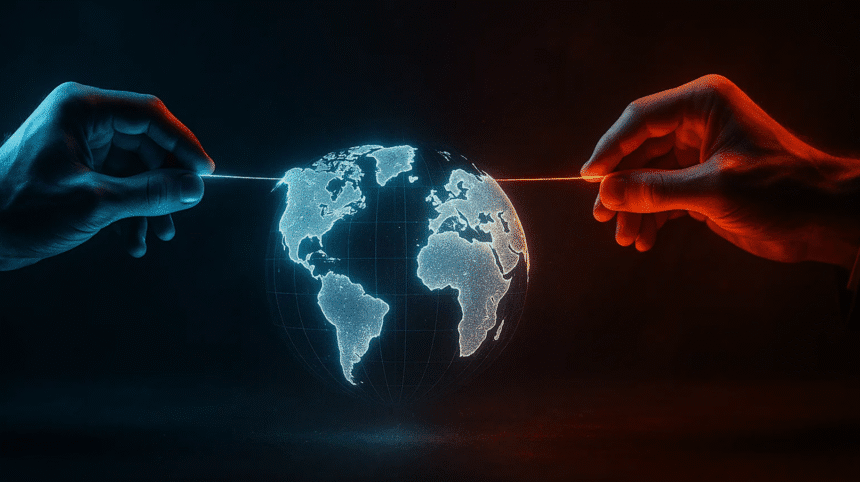The world in 2025 is undergoing a profound transformation, as nations reshape the contours of global influence. Political alliances, technological power, and economic dynamics are shifting in ways unseen since the post–Cold War order, creating a multi-centered global map defined less by borders and more by networks of cooperation, competition, and control. From the expansion of new geopolitical blocs to restructured trade routes and technological rivalries, the map of influence is being redrawn, not on paper, but through power, policy, and production.
The International Monetary Fund (IMF) projects global growth to ease slightly from 3.3% in 2024 to 3.2% in 2025, but the real story lies in the uneven distribution of this growth. Emerging markets, led by Asia, are sustaining an average above 4%, while advanced economies hover around 1.5%. India remains the standout, with growth projections exceeding 6%, confirming its role as a rising economic engine. This divergence marks a slow but steady transfer of global economic gravity toward the East and South, where demography, digitalization, and diversification are rewriting the narrative of global prosperity.
One of the most visible symbols of this realignment is the expansion of BRICS. Once a loose coalition of five emerging powers, it now includes Egypt, Ethiopia, Iran, the UAE, and, as of January 2025, Indonesia. This enlarged bloc, representing major oil exporters, populous consumer markets, and critical trade routes, has evolved into a counterbalance to Western-led financial institutions. The new BRICS+ aims to redefine trade norms, energy pricing, and financial governance, signaling a growing desire for multipolar decision-making. By 2025, BRICS+ nations collectively account for nearly half of global GDP (PPP), surpassing the G7 in purchasing power and influence.
Meanwhile, global defense spending has surged to record highs, reshaping security alliances. Total military expenditures reached $2.718 trillion in 2024, marking a 9.4% year-on-year increase, the fastest since the late Cold War. NATO alone accounts for 55% of this spending, and for the first time in history, all 32 allies are projected to meet the 2% of GDP defense target by 2025. Europe’s rearmament, the Middle East’s continued militarization, and Asia’s defense modernization reflect an era where deterrence has become the new diplomacy. The age of peace dividends has ended; power projection once again defines national prestige.
Technological influence has become the new frontier of power politics. The U.S. and its allies have tightened export controls on advanced semiconductors and AI technologies to restrict China’s access to cutting-edge hardware. These measures, reinforced in 2025, ripple through the global supply chain, affecting companies like the Dutch lithography giant ASML and reshaping the geography of innovation. China’s “AI sovereignty” policy, in response, has accelerated domestic chip development and spurred new alliances in digital infrastructure. The technology race is no longer just about market share; it’s about national security, data governance, and the capacity to compute the future.
Trade and supply chains are also being reconfigured. The U.S.–China tensions have propelled a wave of nearshoring, particularly to Mexico, which has seen record foreign direct investment since 2024. North America is emerging as a powerful manufacturing corridor, especially in the automotive and electronics industries, as global companies prioritize proximity and reliability over low costs. Similarly, Africa’s Continental Free Trade Area (AfCFTA) is gaining traction, turning the continent into a rising voice in trade standardization and digital commerce. With full implementation, intra-African trade could increase by 33% in the coming years, an understated but significant shift in global economic agency.
Europe, too, is redrawing its internal borders of influence. The EU’s 2025 enlargement package praises reforms in Ukraine, Moldova, Montenegro, and Albania, signaling a serious move toward expansion before 2030. Enlargement, once a bureaucratic process, has transformed into a strategic tool to secure Europe’s eastern frontier and stabilize neighboring regions. The new geopolitics of the EU reflect a blend of idealism and pragmatism, anchoring democracy while competing with external powers for influence.
The essence of power in 2025 is no longer about sheer dominance but portfolio influence, a nation’s ability to combine growth, security capacity, technological mastery, and coalition-building. In the past, globalization favored efficiency and market access; today’s world values resilience, alliances, and control over critical technologies. The map of global power now tilts toward countries that can localize production, secure resources, and shape digital and regulatory standards. Influence has become fluid, measured not by landmass or GDP alone, but by the ability to connect, compute, and collaborate.
















